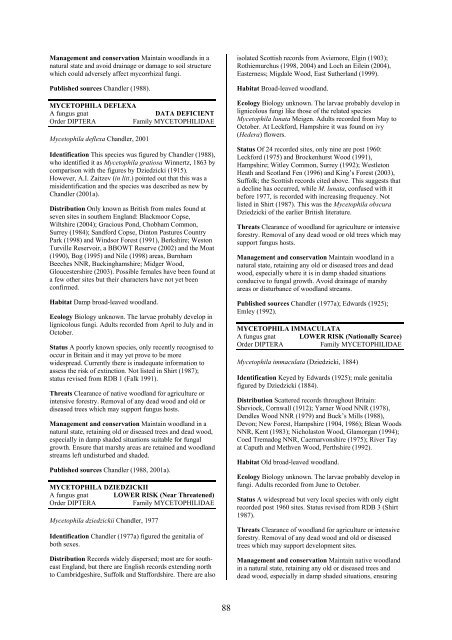Part 2: Nematocera and Aschiza not dealt with by Falk (1991) - JNCC
Part 2: Nematocera and Aschiza not dealt with by Falk (1991) - JNCC
Part 2: Nematocera and Aschiza not dealt with by Falk (1991) - JNCC
You also want an ePaper? Increase the reach of your titles
YUMPU automatically turns print PDFs into web optimized ePapers that Google loves.
Management <strong>and</strong> conservation Maintain woodl<strong>and</strong>s in a<br />
natural state <strong>and</strong> avoid drainage or damage to soil structure<br />
which could adversely affect mycorrhizal fungi.<br />
Published sources Ch<strong>and</strong>ler (1988).<br />
MYCETOPHILA DEFLEXA<br />
A fungus gnat<br />
DATA DEFICIENT<br />
Order DIPTERA<br />
Family MYCETOPHILIDAE<br />
Mycetophila deflexa Ch<strong>and</strong>ler, 2001<br />
Identification This species was figured <strong>by</strong> Ch<strong>and</strong>ler (1988),<br />
who identified it as Mycetophila gratiosa Winnertz, 1863 <strong>by</strong><br />
comparison <strong>with</strong> the figures <strong>by</strong> Dziedzicki (1915).<br />
However, A.I. Zaitzev (in litt.) pointed out that this was a<br />
misidentification <strong>and</strong> the species was described as new <strong>by</strong><br />
Ch<strong>and</strong>ler (2001a).<br />
Distribution Only known as British from males found at<br />
seven sites in southern Engl<strong>and</strong>: Blackmoor Copse,<br />
Wiltshire (2004); Gracious Pond, Chobham Common,<br />
Surrey (1984); S<strong>and</strong>ford Copse, Dinton Pastures Country<br />
Park (1998) <strong>and</strong> Windsor Forest (<strong>1991</strong>), Berkshire; Weston<br />
Turville Reservoir, a BBOWT Reserve (2002) <strong>and</strong> the Moat<br />
(1990), Bog (1995) <strong>and</strong> Nile (1998) areas, Burnham<br />
Beeches NNR, Buckinghamshire; Midger Wood,<br />
Gloucestershire (2003). Possible females have been found at<br />
a few other sites but their characters have <strong>not</strong> yet been<br />
confirmed.<br />
Habitat Damp broad-leaved woodl<strong>and</strong>.<br />
Ecology Biology unknown. The larvae probably develop in<br />
lignicolous fungi. Adults recorded from April to July <strong>and</strong> in<br />
October.<br />
Status A poorly known species, only recently recognised to<br />
occur in Britain <strong>and</strong> it may yet prove to be more<br />
widespread. Currently there is inadequate information to<br />
assess the risk of extinction. Not listed in Shirt (1987);<br />
status revised from RDB 1 (<strong>Falk</strong> <strong>1991</strong>).<br />
Threats Clearance of native woodl<strong>and</strong> for agriculture or<br />
intensive forestry. Removal of any dead wood <strong>and</strong> old or<br />
diseased trees which may support fungus hosts.<br />
Management <strong>and</strong> conservation Maintain woodl<strong>and</strong> in a<br />
natural state, retaining old or diseased trees <strong>and</strong> dead wood,<br />
especially in damp shaded situations suitable for fungal<br />
growth. Ensure that marshy areas are retained <strong>and</strong> woodl<strong>and</strong><br />
streams left undisturbed <strong>and</strong> shaded.<br />
Published sources Ch<strong>and</strong>ler (1988, 2001a).<br />
MYCETOPHILA DZIEDZICKII<br />
A fungus gnat LOWER RISK (Near Threatened)<br />
Order DIPTERA<br />
Family MYCETOPHILIDAE<br />
Mycetophila dziedzickii Ch<strong>and</strong>ler, 1977<br />
Identification Ch<strong>and</strong>ler (1977a) figured the genitalia of<br />
both sexes.<br />
Distribution Records widely dispersed; most are for southeast<br />
Engl<strong>and</strong>, but there are English records extending north<br />
to Cambridgeshire, Suffolk <strong>and</strong> Staffordshire. There are also<br />
isolated Scottish records from Aviemore, Elgin (1903);<br />
Rothiemurchus (1998, 2004) <strong>and</strong> Loch an Eilein (2004),<br />
Easterness; Migdale Wood, East Sutherl<strong>and</strong> (1999).<br />
Habitat Broad-leaved woodl<strong>and</strong>.<br />
Ecology Biology unknown. The larvae probably develop in<br />
lignicolous fungi like those of the related species<br />
Mycetophila lunata Meigen. Adults recorded from May to<br />
October. At Leckford, Hampshire it was found on ivy<br />
(Hedera) flowers.<br />
Status Of 24 recorded sites, only nine are post 1960:<br />
Leckford (1975) <strong>and</strong> Brockenhurst Wood (<strong>1991</strong>),<br />
Hampshire; Witley Common, Surrey (1992); Westleton<br />
Heath <strong>and</strong> Scotl<strong>and</strong> Fen (1996) <strong>and</strong> King’s Forest (2003),<br />
Suffolk; the Scottish records cited above. This suggests that<br />
a decline has occurred, while M. lunata, confused <strong>with</strong> it<br />
before 1977, is recorded <strong>with</strong> increasing frequency. Not<br />
listed in Shirt (1987). This was the Mycetophila obscura<br />
Dziedzicki of the earlier British literature.<br />
Threats Clearance of woodl<strong>and</strong> for agriculture or intensive<br />
forestry. Removal of any dead wood or old trees which may<br />
support fungus hosts.<br />
Management <strong>and</strong> conservation Maintain woodl<strong>and</strong> in a<br />
natural state, retaining any old or diseased trees <strong>and</strong> dead<br />
wood, especially where it is in damp shaded situations<br />
conducive to fungal growth. Avoid drainage of marshy<br />
areas or disturbance of woodl<strong>and</strong> streams.<br />
Published sources Ch<strong>and</strong>ler (1977a); Edwards (1925);<br />
Emley (1992).<br />
MYCETOPHILA IMMACULATA<br />
A fungus gnat LOWER RISK (Nationally Scarce)<br />
Order DIPTERA<br />
Family MYCETOPHILIDAE<br />
Mycetophila immaculata (Dziedzicki, 1884)<br />
Identification Keyed <strong>by</strong> Edwards (1925); male genitalia<br />
figured <strong>by</strong> Dziedzicki (1884).<br />
Distribution Scattered records throughout Britain:<br />
Sheviock, Cornwall (1912); Yarner Wood NNR (1978),<br />
Dendles Wood NNR (1979) <strong>and</strong> Buck’s Mills (1988),<br />
Devon; New Forest, Hampshire (1904, 1986); Blean Woods<br />
NNR, Kent (1983); Nicholaston Wood, Glamorgan (1994);<br />
Coed Tremadog NNR, Caernarvonshire (1975); River Tay<br />
at Caputh <strong>and</strong> Methven Wood, Perthshire (1992).<br />
Habitat Old broad-leaved woodl<strong>and</strong>.<br />
Ecology Biology unknown. The larvae probably develop in<br />
fungi. Adults recorded from June to October.<br />
Status A widespread but very local species <strong>with</strong> only eight<br />
recorded post 1960 sites. Status revised from RDB 3 (Shirt<br />
1987).<br />
Threats Clearance of woodl<strong>and</strong> for agriculture or intensive<br />
forestry. Removal of any dead wood <strong>and</strong> old or diseased<br />
trees which may support development sites.<br />
Management <strong>and</strong> conservation Maintain native woodl<strong>and</strong><br />
in a natural state, retaining any old or diseased trees <strong>and</strong><br />
dead wood, especially in damp shaded situations, ensuring<br />
88
















